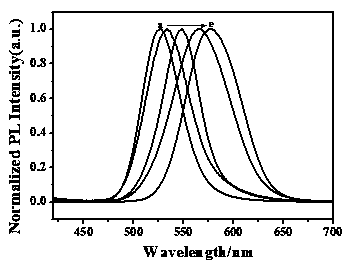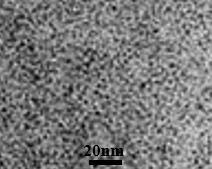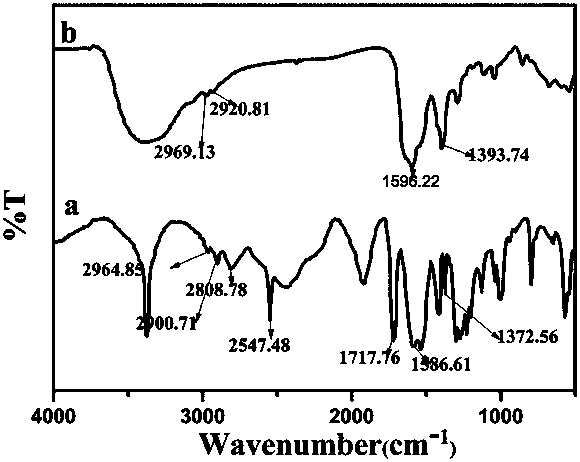Photoelectric immunosensor based on water-soluble Zn-Mg-Te quantum dot/titanium dioxide nanorod composite material
A zn-mg-te, titanium dioxide technology, applied in the direction of titanium dioxide, selenium/tellurium compounds, material electrochemical variables, etc., can solve the problem of low photoelectric conversion efficiency, to maintain antibody biological activity, strong fluorescence intensity and stability, The effect of good application prospects
- Summary
- Abstract
- Description
- Claims
- Application Information
AI Technical Summary
Problems solved by technology
Method used
Image
Examples
Embodiment 1
[0046] A preparation method of water-soluble Zn-Mg-Te quantum dots, comprising steps as follows:
[0047] Preparation of NaHTe solution: under the protection of nitrogen, add 80mg NaBH4 and 10ml water into a 25ml three-necked flask in turn, react in an ice bath, add 127mg tellurium powder, and react for 4 hours. After the black tellurium powder reacts completely, a colorless and transparent NaHTe solution is obtained, which is set aside ;
[0048] Scheme 1: Under the protection of nitrogen, add 60mL 0.002mol / L ZnCl to the three-neck round bottom flask successively 2 solution, 20mL 0.016mol / L N-acetyl-L-cysteine solution and 20mL double distilled water, mix well to obtain a mixed solution; use 1mol / L NaOH solution to adjust the pH value of the mixed solution to 11.5; add 0.5mL 0.01mol / L MgCl 2 solution, protected from light for 0.5h; then add 3mL of freshly prepared NaHTe solution, and react at 100°C for 5h to obtain a fluorescence emission wavelength of 580nm, such as fi...
Embodiment 2
[0055] A preparation method of water-soluble Zn-Mg-Te quantum dot / titanium dioxide nanorod composite material, comprising steps as follows:
[0056] S1. Preparation of titanium dioxide nanorods: under an ice-water bath, slowly add 1.8ml of titanium tetrachloride to a beaker containing 19ml of ultrapure water, stir vigorously for 10min to obtain a white suspension, then add 1.8ml of chloroform to the mixture, Stirring was continued for 10 minutes, the mixture was transferred to a polytetrafluoroethylene-lined autoclave, reacted at 180°C for 6 hours, cooled to room temperature, and the white precipitate was collected by centrifugation, washed with deionized water and absolute ethanol to pH 7.0, and then Vacuum dry at 60°C for 12 hours, store at room temperature for later use;
[0057]S2. Amination of titanium dioxide nanorods: place 100 mg of titanium dioxide nanorods prepared in step S1 in a mixture containing 20 ml of ethanol, 1 ml of ammonia solution with a mass concentration...
Embodiment 3
[0065] Such as Figure 8 Shown, a kind of preparation method based on the squamous cell carcinoma photoelectric immunosensor of water-soluble Zn-Mg-Te quantum dot / titanium dioxide nanorod composite material, its steps are as follows:
[0066] (1) bare glassy carbon electrode (diameter 3 mm), polished with 0.3 μm Al2O3 suspension, rinsed with distilled water, and then successively in HNO 3 (formed by mixing equal volumes of 65wt% concentrated nitric acid and water), ethanol (50v / v%), ultrasonically cleaned in twice distilled water, and dried for later use;
[0067] (2) Construction of SCCA photoelectric immunosensor:
[0068] Take 6 μ L of the Zn-Mg-Te / TiO prepared in Example 2 2 The composite material was drip-coated on the surface of the clean glassy carbon electrode obtained in step (1), dried at room temperature, and washed with 0.01 mol / L PBS buffer solution with pH=7.4 to obtain Zn-Mg-Te / TiO 2 / GCE modified electrode;
[0069] Then take 6 μL of 10 μg / mL squamous cell...
PUM
| Property | Measurement | Unit |
|---|---|---|
| The average diameter | aaaaa | aaaaa |
| Average length | aaaaa | aaaaa |
| Diameter | aaaaa | aaaaa |
Abstract
Description
Claims
Application Information
 Login to View More
Login to View More - R&D
- Intellectual Property
- Life Sciences
- Materials
- Tech Scout
- Unparalleled Data Quality
- Higher Quality Content
- 60% Fewer Hallucinations
Browse by: Latest US Patents, China's latest patents, Technical Efficacy Thesaurus, Application Domain, Technology Topic, Popular Technical Reports.
© 2025 PatSnap. All rights reserved.Legal|Privacy policy|Modern Slavery Act Transparency Statement|Sitemap|About US| Contact US: help@patsnap.com



